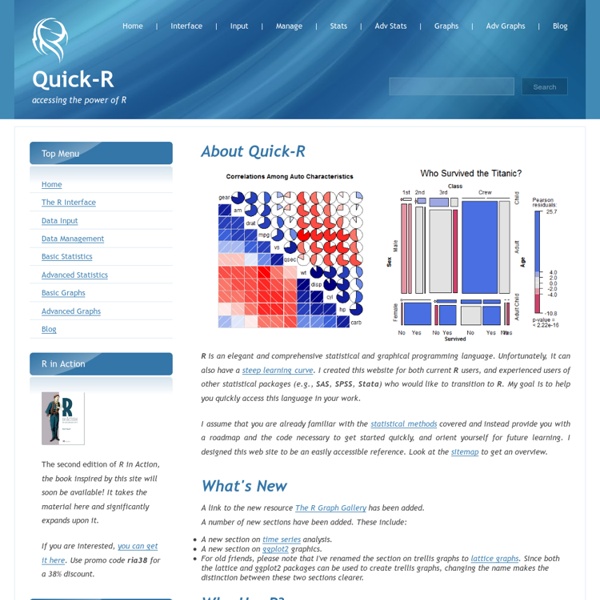



高校の数学とコンピュータ 2000ǯ11·î06ÆüÀßÃÖ¡¡2001ǯ9·î29ÆüÊѹ¹ ¤³¤Î¤¿¤Ó¡¢¿ÈÊÕ¤¬Ë»¤·¤¯¤Ê¤Ã¤Æ¤¤¿¤¿¤á¡¢¤Þ¤³¤È¤Ë¿½¤·Ìõ¤¢¤ê¤Þ¤»¤ó¤¬ ¹¹¿·¤ò½ªÎ»¤µ¤»¤Æ¤¤¤¿¤À¤¤Þ¤¹¡£¡Ê¤â¤¦¤º¤¤¤Ö¤óÁ°¤«¤é¹¹¿·¤·¤Æ¤Þ¤»¤ó¤¬(^^; )¡£Ä¹¤¤´Ö¡¢¤´°¦Æɤ¢¤ê¤¬¤È¤¦¤´¤¶¤¤¤Þ¤·¤¿¡£ ¥á¡¼¥ë¤Î¤Û¤¦¤â¤á¤Ã¤¿¤Ë¸«¤ë¤³¤È¤Ï¤Ê¤¯¤Ê¤ê¤Þ¤¹¤Î¤Ç¡¢¼ºÎé¤Ê¤¬¤é¤ªÊÖ»ö¤Ïº¹¤·¾å¤²¤é¤ì¤Ê¤¤¤«¤È»×¤¤¤Þ¤¹¡£ ¤Ê¤ª°ú¤Â³¤¥³¥ó¥Æ¥ó¥Ä¤Ï»Ä¤·¤Æ¤ª¤¤Þ¤¹¤Î¤Ç¡¢Ä¾ÀÜŪ¤Ê±ÄÍøÌÜŪ°Ê³°¤Ç¤·¤¿¤é¡¢¤´¼«Í³¤Ë¤´ÍøÍѤ¯¤À¤µ¤¤¡£ ±ÜÍ÷¤·¤Æ¤¯¤À¤µ¤Ã¤¿³§¤µ¤óËÜÅö¤Ë¤¢¤ê¤¬¤È¤¦¤´¤¶¤¤¤Þ¤·¤¿¡£(2003.10.27) ¤è¤¦¤³¤½¡¢¤¤¤í¤¤¤í¤Ê¥½¥Õ¥È¥¦¥§¥¢¤Î¾Ò²ð¤ä̵ÎÁ¥À¥¦¥ó¥í¡¼¥É¤Ê¤É¤·¤Æ¤¤¤Þ¤¹¡£ ¤¤¤é¤·¤Æ¤¯¤ì¤¿Êý¡¢À§Èó¥²¥¹¥È¥Ö¥Ã¥¯¤Ë¤âÂÀפò»Ä¤·¤Æ¤¯¤À¤µ¤¤¡£ R¤Ç¤ß¤ë¹â¹»¿ô³Ø ¹â¹»¿ô³Ø³Îǧ¥×¥ê¥ó¥È Using R for statistical analyses - Introduction Help and Documentation My Publications See my books about R at my Publications Page: Statistics for Ecologists using R and Excel. Beginning R: The Statistical Progreamming Language. The Essential R Reference. Documents There are plenty of sources of help and information regarding R. “Using R for Data Analysis and Graphics - Introduction, Examples and Commentary” by John Maindonald [PDF]. These are available via the 'Contributed Documentation' section. Courses From 2009 I am going to be running a series of short courses in data analyses for conservation biologists. Help within R The help system within R is comprehensive. Click on the 'Help' menu. If you want help on a specific command you can enter a search directly from the keyboard: help(keyword) A shortcut is to type: ? This is fine if you know the command you want. apropos("part.word") You type in a part.word and R will list all commands that contain that string of letters. If you run the HTML help you will see a heading entitled "Packages".
RGraphExampleLibrary: R Example Graph Library Introduction I wondered why there wasn't a website with output of the many examples of R packages. Well, here it is. Using the library Just click on the 'packages' tab for an overview of R packages.After selecting a R package a list of small plots is displayed. Arrg, It Does Not Work ... The example code and log output is currently not available. The Making of ... Essential ingredients: R を利用する この文章は2001年に書いたもので、かなり古くなってしまいました。 現在では Rjp wiki などを参照されたほうが良いと思います。 R はベル研究所で開発された S 言語に基づいたデータ解析用の環境で、 自由なソフト、オープンソースウェアとして公開されています。 ここでは詳しい説明ははぶくので、R に確実に入門するには CRAN のAn Introduction to R CRAN:Manuals 、あるいはその日本語訳 統計言語 R の関連ドキュメントの和訳 を読むことをおすすめします。 もちろん、データの扱いをすべて R に頼るというわけではないので perl などによるテキストデータの扱いに慣れていることも Unix 上でデータ解析をするのに必要でしょう。 データ解析の流れ 起動法 データの読み込み データフレームの編集 データを見る 統計モデル (直線回帰、非線形回帰) を当てはめてみる Tips example の利用 パッケージの読み込み 起動時のオプション テキストファイルへの入出力 データの編集 関数のプロット プロットの軸の操作 エラーバー付きのプロット 3次元プロット 描画したプロットを記録 基本的な統計法 分散分析と多重比較 相関 頻度の検定 フィッシャーの正確確率検定 ノンパラメトリック検定 Mann-Whitney U 検定 npmc を使った多重比較 一般化線型モデル 統計モデルの構造と例 オフセットありのポアソン GLM R 入門への参考 R あるいは S を知らない人のために、まず一通りどのように解析していくか、 簡単な例で流れをつかんでみます。 R はコンソールから対話的に利用することも、 言語をファイルから読み込んで自動的に作業をすることもできます。 R を kterm などのコンソールから直接使うと、 関数や変数に何があるのか補完してくれないため、 それらを覚えておかなければならず不便です。 手順としては、まず emacs を動かし、M-x R と入力してリターンキーを押します (Alt キーを押しながら x をタイプし、その後 R と入力します)。 ESS [S(R): R] stating data directory? と聞いてくるので、作業をするディレクトリを指定します。 テキストファイルのデータを読み込んでみます。 これを R に読み込むには とするだけです。 とします。 となります。 p
Analyse Canonique des Correspondances dans XLSTAT-ADA | Tutoriel Analyse Canonique des Correspondances L’Analyse Canonique des Correspondances ou ACC (Canonical Correspondence Analysis ou CCA en anglais) a été développée dans le but de permettre aux écologues de relier les abondances d’espèces à des variables environnementales (Ter Braak, 1986). Cependant on peut envisager d’utiliser cette méthode dans d’autres domaines comme le géomarketing. Pour pouvoir utiliser une Analyse Canonique des Correspondances il est nécessaire de disposer, d’un tableau de contingence X qui contient les effectifs ou les fréquences d’une série d’objets (en écologie, des espèces) mesurés en plusieurs sites,un tableau Y de variables descriptives mesurées en ces mêmes sitesoptionnellement un tableau Z qui contient des variables descriptives dont on veut retirer l’effet avant d’expliquer la variabilité de X en utilisant Y. Jeu de données pour l'Analyse Canonique des Correspondances et but de ce tutoriel Paramétrer une Analyse Canonique des Correspondances
Introduction to Statistical Computing in R A statistical package, such as SPSS or SAS, is primarily oriented toward combining instructions with rectangular case-by-variable datasets to produce (often voluminous) printouts. Such packages make routine data analysis relatively easy, but they make it relatively difficult to do things that are innovative or non-standard, or to add to the built-in capabilities of the package. In contrast, a good statistical computing environment also makes routine data analysis easy, but it additionally supports convenient programming; this means that users can extend the already impressive facilities of R. Statisticians and others have taken advantage of the extensibility of R to contribute more than 2000 freely available “packages” of documented R programs and data to CRAN ( the Comprehensive R Archive Network) and many others to the Bioconductor package archive. Precompiled binaries for popular Linux systems are available from CRAN, or users can compile R from source. Installing the car Package R.
The R Project for Statistical Computing Presses Universitaires de Rennes r4stats.com | Analyzing the World of Analytics